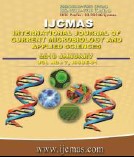


 National Academy of Agricultural Sciences (NAAS)
National Academy of Agricultural Sciences (NAAS)

|
PRINT ISSN : 2319-7692
Online ISSN : 2319-7706 Issues : 12 per year Publisher : Excellent Publishers Email : editorijcmas@gmail.com / submit@ijcmas.com Editor-in-chief: Dr.M.Prakash Index Copernicus ICV 2018: 95.39 NAAS RATING 2020: 5.38 |
Department of Vegetable Science, C. C. S. Haryana Agricultural University, Hisar-125004, Haryana, IndiaGenetic divergence of 30 okra genotypes was studied using Mahalanobis D2 statistics revealed that considerable genetic diversity among genotypes in okra. Thirty diverse genotypes were grouped into six clusters with the highest of 11 genotypes in the cluster II, 10 in the cluster I, 4 genotypes in the cluster III, 3 in cluster V and 1 in each IV and VI cluster. The inter cluster distance was higher than the intra cluster distance indicating wide genetic diversity among the genotypes of different groups. The cluster means of 10 characters among six clusters indicated that high genetic variability range present for fruit yield per plant (174.7 g in cluster V to 350.14 g in cluster III), followed by fruits/plant (20.83 in cluster V to 40.03 in cluster III) and average weight of fruit (7.667 g in cluster IV to 10.033 g in cluster VI). The relative contribution of studied characters indicated that branches per plant had contributed highest (41.61 %) followed by fruit yield per plant (31.49 %), fruits per plant (15.17 %), nodes (1st Flowering node to end) (8.97), stem diameter (1.61). Based on principal component analysis (PCA), the first four components explained 87.83% of total genetic variation. These characters are highly genetic variable and genotype having these characters in different cluster could be used in breeding programme to develop high yielding cultivars in okra.
 |
 |
 |
 |
 |